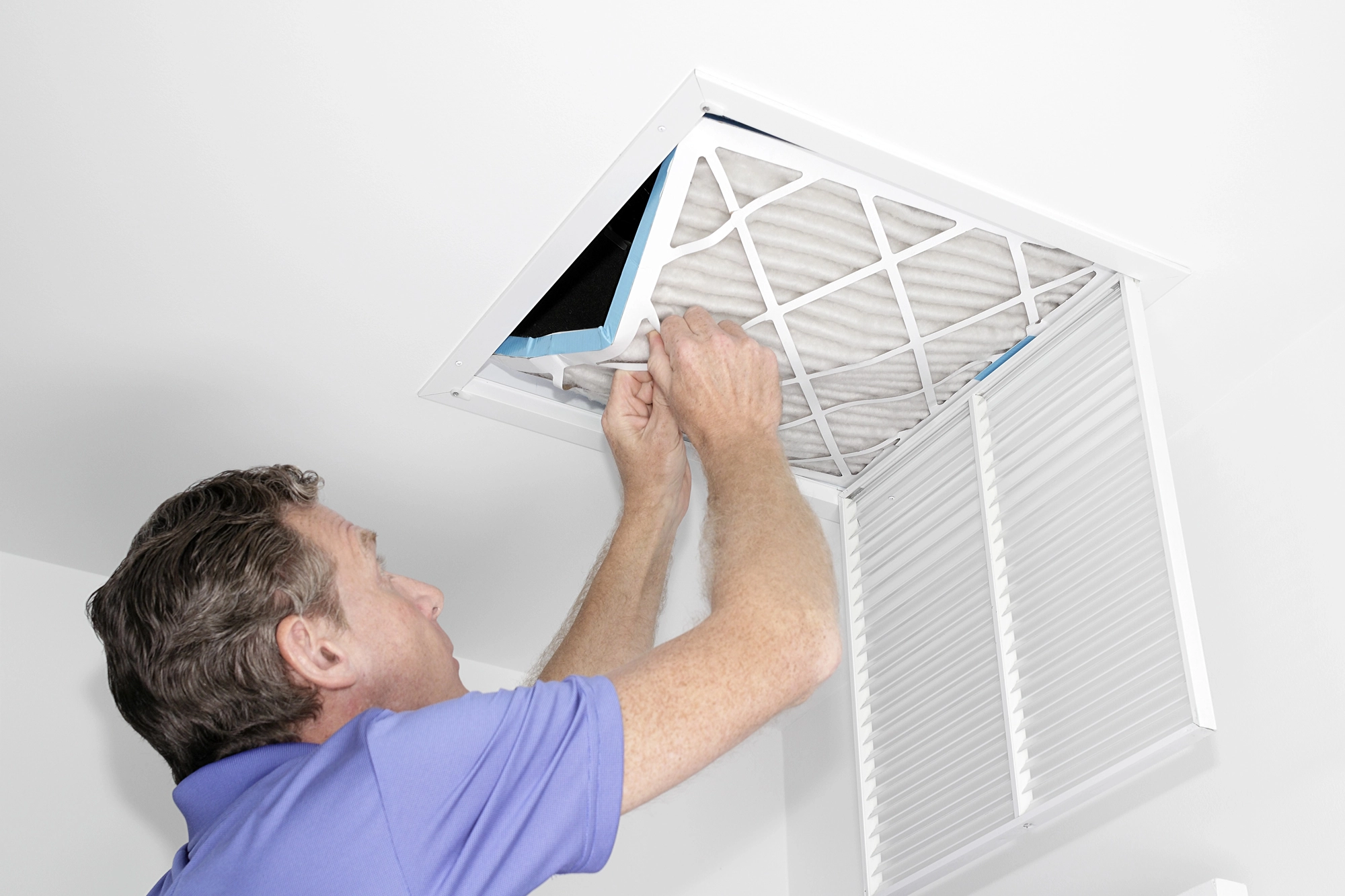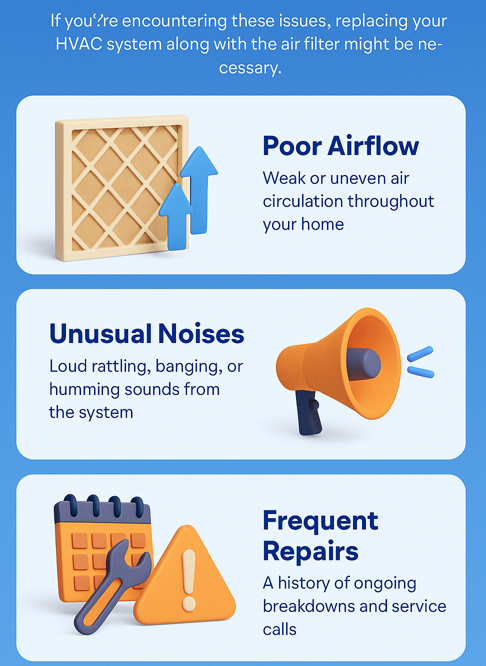Is Your Air Filter 14x14x1 Warning You About a Failing HVAC Unit?
Homeowners often assume that a clogged air filter 14x14x1 is the culprit behind weak airflow or rising energy bills—but that’s only part of the story. In our experience performing hundreds of HVAC replacement jobs, we’ve seen a recurring pattern: when these symptoms persist even after regular filter changes, the real issue often lies deeper within the HVAC system itself.
From deteriorating blower motors to aging ductwork and overworked compressors, small filter-related problems can be the early warning signs of full system failure. In this article, we’ll show you how to tell the difference between a filter fix and a system-wide red flag—based on what we’ve learned in the field. You’ll get practical guidance, expert-backed diagnostics, and cost-saving advice that goes beyond the basics.
Top Takeaways
- Filter issues ≠ system fix.
- No airflow improvement?It could mean blower failure, coil blockage, or duct leaks.
- Old systems = high costs.Units over 12–15 years waste energy—even with clean filters.
- New HVAC = real savings.Replacements can cut energy use by up to 50%.
- Act early, save more.Don’t wait for a breakdown—schedule a system check now.
When a Filter Swap Isn’t Enough: What Your 14x14x1 Air Filter Might Be Telling You
If you're regularly changing your 14x14x1 air filter but still experiencing stuffy air, inconsistent temperatures, or high utility bills, your HVAC system may be signaling deeper issues. Based on real-world service calls, here are signs your filter is no longer the problem—and HVAC replacement could be next:
- Frequent Filter Clogs: If your 14x14x1 filter is filling up unusually fast, it could mean your system is overcompensating for declining performance or poor duct design.
- Reduced Airflow After Filter Change: When airflow doesn’t improve after a clean filter install, failing blower motors or restricted ducts may be to blame.
- Constant Cycling or Noise: Excessive HVAC cycling or new mechanical noises often indicate aging internal components struggling to keep up—especially common in 10+ year-old systems.
- Humidity & Air Quality Issues: If your indoor environment stays humid or dusty despite regular maintenance, your system may no longer be regulating properly.
- Skyrocketing Energy Costs: A fresh air filter should help reduce energy use—if it doesn’t, inefficiencies elsewhere in the system may require a full replacement.
What the Experts Say
“We’ve had clients replace their 14x14x1 filters like clockwork, only to find their coil was clogged or the motor was overheating,” says Marcos E., HVAC technician with 15+ years of experience. “Once you’ve ruled out the filter, it’s time to look at the system as a whole.”
When to Consider Replacement
If your HVAC system is more than 12 years old and showing multiple signs above, it may be more cost-effective to invest in a new system rather than continuing piecemeal fixes. An experienced technician can assess whether repairs will extend life—or if a modern, energy-efficient unit will save you more in the long run.

“When we see a homeowner replacing their 14x14x1 filter every month and still dealing with airflow issues or rising energy bills, it's almost always a symptom—not the root cause. In many cases, the HVAC system is running beyond its intended lifespan, compensating with longer cycles and strained components. That’s when we advise stepping back and evaluating the system as a whole—because no filter can fix a failing compressor or aging ductwork. Recognizing those early signs can prevent a complete breakdown and save thousands in emergency costs.”
Case Study: When a 14x14x1 Air Filter Wasn’t the Problem
Mitchell Residence – Overland Park, KS
The Situation
- Homeowners changed their 14x14x1 filter every 30 days.
- Still had weak airflow, high humidity, and rising energy bills.
- HVAC system was over 15 years old.
What We Discovered
Despite clean filters, system performance kept dropping. Our inspection revealed:
- Failing Blower Motor – Overheating and running at 60% output.
- Blocked Evaporator Coil – Reducing cooling capacity.
- Leaky Return Ducts – Wasting air and reducing efficiency.
- Outdated System – Still used phased-out R-22 refrigerant.
The Fix
Instead of patchwork repairs, we recommended full HVAC replacement. The Mitchells agreed.
The Results
After installation of a high-efficiency system:
- 31% lower energy bills in 60 days
- Even airflow in all rooms
- Balanced humidity and fewer allergy symptoms
“We thought it was a filter issue. Turns out the whole system was worn out,” — Mr. Mitchell
Field Insight & Research
We’ve seen this pattern repeatedly. When filters don’t solve airflow issues, it's often deeper.
- In 2024, the Building Performance Institute found:67% of HVAC systems over 12 years old with frequent filter issues had internal component failures.
Supporting Statistics
We see this often: a clean 14x14x1 filter isn’t fixing airflow or comfort. Why? Because the HVAC system itself may be past its performance peak. These trusted stats support what we encounter in the field:
1. Old Systems Lose Efficiency
- HVAC systems over 10–15 years old often underperform, even with clean filters.
- Upgrading to ENERGY STAR systems can save up to 20% on annual energy costs.ENERGYSTAR.gov
2. Modern Systems = Major Energy Savings
- New electric HVAC units can cut energy use by up to 50%.
- Gas systems can improve efficiency by 10% or more.
- We’ve seen real-world results immediately post-installation.rpsc.energy.gov
3. Filter Problems Often Signal System Failure
- In homes we’ve serviced, recurring filter issues often point to deeper faults:
- Coil blockage
- Blower motor strain
- Duct leakage
- 67% of HVAC systems over 12 years old with repeated filter complaints had internal failures.bpihomeowner.org
What This Means on the Ground
- Filters are often the symptom, not the solution.
- When basic maintenance doesn’t fix comfort, it’s time to assess the system.
These stats match what we’ve seen across hundreds of residential service calls.
Final Thoughts & Pro Insight
What We’ve Learned in the Field:
- Many homeowners change filters on schedule—but still face poor airflow or high energy bills.
- The real issue is often hidden: aging components, blocked coils, or duct leaks.
- Filters are essential maintenance—but not a cure-all.
If You Notice These After Replacing Your Filter:
- Inconsistent temperatures
- High utility bills
- Weak or noisy airflow
- Humidity problems
- Filter clogs more than usual
Your HVAC system could be signaling it’s time for replacement—not just maintenance.
Our Honest Opinion:
- Don’t keep spending on filters and quick fixes if deeper issues persist.
- If your system is 12+ years old, a proactive assessment could save you thousands in emergency costs.
- Most costly breakdowns we see could’ve been prevented with early replacement planning.
Next Steps: What to Do Now
If a new 14x14x1 filter isn’t fixing your HVAC issues, here’s what to do next:
1. Book a System Diagnostic
- Get a full HVAC check—not just a filter review.
- Spot issues like motor strain, coil blockages, or airflow loss.
2. Check Your System’s Age
- Is it 12–15+ years old?
- Older units often cost more to run and repair than to replace.
3. Request an Energy Use Assessment
- Learn how much your current system is wasting.
- Newer systems can cut energy use by up to 50%.
4. Verify Filter Compatibility
- Make sure your 14x14x1 filter is the right fit and MERV rating.
- A bad match can restrict airflow and hurt performance.
5. Compare Replacement Options
- Ask for a personalized quote.
- Review SEER ratings, warranties, and available financing.
Frequently Asked Questions
1. What does “14x14x1” mean in an air filter?
“14x14x1” refers to the filter’s dimensions in inches—14 inches wide, 14 inches long, and 1 inch thick. Always check your HVAC system’s specs, as filters must fit snugly for optimal airflow and filtration.
2. How often should I replace a 14x14x1 air filter?
Most 14x14x1 filters should be replaced every 30–90 days. If you have pets, allergies, or live in a high-dust area, check it monthly. A clogged filter reduces HVAC efficiency and indoor air quality.
3. Are there different types of 14x14x1 filters?
Yes. You can choose from fiberglass, pleated, electrostatic, and HEPA-style filters. Filters also vary in MERV rating, which measures filtration efficiency. Higher MERV = better particle capture, but may reduce airflow if your system isn’t rated for it.
4. Will using the wrong size filter affect my HVAC system?
Absolutely. Using a poorly fitting or incorrect-sized filter—like a loose or undersized 14x14x1—can lead to bypassed air, dust buildup, and decreased system efficiency. Always use the exact size recommended by your unit’s manufacturer.
5. Where can I buy a 14x14x1 air filter?
You can find 14x14x1 filters at home improvement stores, online retailers and local HVAC suppliers. Choose reputable brands and verify the MERV rating meets your indoor air needs.
Learn more about HVAC Care from one of our HVAC solutions branches…
Filterbuy HVAC Solutions - Miami FL - Air Conditioning Service
1300 S Miami Ave Apt 4806 Miami FL 33130
(305) 306-5027
https://maps.app.goo.gl/Ci1vrL596LhvXKU79







